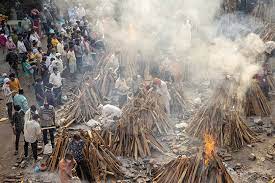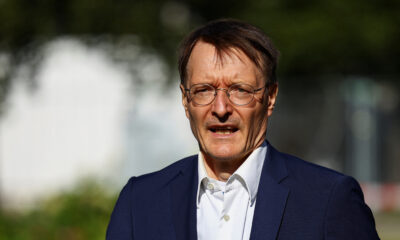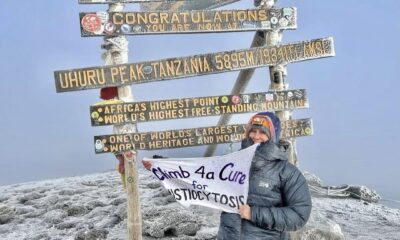Indians rush for vaccines as COVID-19 death toll passes 200,000
NEW DELHI (Reuters) -Indians struggled to register online for a mass vaccination drive set to begin at the weekend as the country’s toll from the coronavirus surged past 200,000 on Wednesday, worsened by shortages of hospital beds and medical oxygen.
The second wave of infections has seen at least 300,000 people test positive each day for the past week, overwhelming health facilities and crematoriums and prompting an increasingly urgent response from allies overseas sending equipment.
The last 24 hours brought 360,960 new cases for the world’s largest single-day total, taking India’s tally of infections to nearly 18 million. It was also the deadliest day so far, with 3,293 fatalities carrying the toll to 201,187.
Experts believe the official tally vastly underestimates the actual toll in a nation of 1.35 billion, however.
“The situation is horrific, absolutely terrible … Everyone is afraid, every single person. People are afraid that if I am talking to a person, maybe I won’t get to talk to them tomorrow or in the near future,” New Delhi resident Manoj Garg said.
Delhi state is reporting one death from COVID-19 every four minutes and ambulances have been taking the bodies of COVID-19 victims to makeshift crematorium facilities in parks and parking lots, where bodies burned on rows and rows of funeral pyres.
Mohammad Shameem, the head grave digger at Delhi’s biggest graveyard, said: “Earlier we had enough space here but now there is no space left. Whatever little gaps we have left, we are trying to fill them up now.”
Genesis hospital in the Delhi suburb of Gurgaon told families to take patients away because its supplies of life-saving oxygen were depleting fast, one family said.
“The hospital is trying to get fresh oxygen but we are told we have to make alternate arrangements,” said Anjali Cerejo, whose father had been admitted but now has to try to find another bed elsewhere.
Outside hospitals, people lined up on trolleys, and in cars and cycle rickshaws, with loved ones holding oxygen cylinders for them as they waited for a bed inside.
The World Health Organization said in its weekly epidemiological update that India accounted for 38% of the 5.7 million cases reported worldwide to it last week.
Early modelling showed that the B.1.617 variant of the virus detected in India had a higher growth rate than other variants in the country, suggesting increased transmissibility, it said.
SEARCH FOR VACCINES
Delhi Chief Minister Arvind Kejriwal said people were falling sick more severely and for longer periods in the second wave, stacking up the pressure on the health system.
“The current wave is particularly dangerous,” he said. “It is supremely contagious and those who are contracting it are not able to recover as swiftly. In these conditions, intensive care wards are in great demand.”
Experts said India’s best hope was to vaccinate its vast population and on Wednesday it opened registrations for everyone above the age of 18 to be given jabs from Saturday.
But the country, which is one of the world’s biggest producers of vaccines, does not yet have the stocks for the estimated 600 million people becoming eligible, on top of the ongoing effort to inoculate the elderly and people with other medical conditions.
People who tried to sign up said they failed, complaining on social media that they could not get a slot or they simply could not get online to register as the website repeatedly crashed.
“Tried registering and blocking a slot for vaccination,” said Shourya Agarwal on Twitter. “Failed multiple times.”
Even those already eligible were struggling to find doses.
“They are telling us that injections are not available, as vaccines have not arrived,” said Mumbai resident Pushpa Goswami at a vaccination centre. She said she registered three days ago.
The South Asia head of the International Federation of Red Cross and Red Crescent Societies, Udaya Regmi, said the world was entering a critical phase of the pandemic and needed to have vaccinations available for all adults as soon as possible.
“This is both an ethical and public health imperative,” he added. “As variants keep spreading, this pandemic is far from over until the whole world is safe.”
The United States is sending supplies worth more than $100 million to India, including 1,000 oxygen cylinders, 15 million N95 masks and 1 million rapid diagnostic tests, the White House said in a statement on Wednesday. It said the supplies will begin arriving on Thursday.
The United States also has redirected its own order of AstraZeneca manufacturing supplies to India, which will allow it to make over 20 million doses of COVID-19 vaccine, according to the White House.
LOCKDOWN CALL
About 9% of India’s population have received one dose since the vaccination campaign began in January with healthworkers and then the elderly.
Epidemiologist Bhramar Mukherjee said India must combine the immunisation drive with a widespread lockdown to slow the spread.
“At this point, lives are so much more important than livelihoods,” the University of Michigan professor said on Twitter. “Provide assistance to the poor, but please lock down and vaccinate.”
Delhi is under a lockdown until next week and the government of the western state of Maharashtra, home to financial capital, Mumbai, said it was considering extending its lockdown until mid-May.
Prime Minister Narendra Modi’s government, which imposed a severe lockdown on the country when the pandemic struck last year, has opposed such a measure because of the risk to an economic recovery that was under way before the second wave struck.
Credit rating agency S&P Global said India’s second wave could expose other nations to further outbreaks. The Asia-Pacific region was particularly susceptible to contagion give its low ratios of vaccination.












